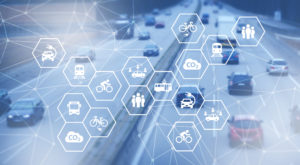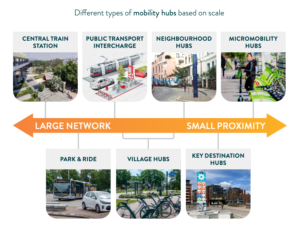The multiple health benefits of public transport
Robust, effective public transit systems positively contribute to clean air goals in cities. Public transport is an investment in public health. Investing in public transit supports clean air goals by shifting transport load off of single-occupancy cars and into multimodal transit options. Car use and traffic congestion are major contributors to air pollution. Cities account for 70% of carbon emissions a majority of which come from transport and energy, and road vehicles account for around 75% of those transport emissions.
The United Nations Sustainable Development Goal 11.2 aims to expand the proportion of the population that has convenient access to public transport. Up to 99% of the world’s inhabitants breathe air containing pollutants exceeding the WHO guideline values. Cities need to invest in active and public transportation infrastructure to improve urban air quality. New advancements in digital technology integration improve the transitions and accessibility of multimodal transportation.
Along with reducing air pollution, there are substantial health benefits from shifting mobility loads to active and public transit. To meet Sustainable Development Goals decarbonizing individual private transport is not enough. Road vehicles will still consume three times more energy and create three times more carbon emissions per passenger than public transit.
Multimodal public transport
A modal shift towards active and public transit is needed and can be achieved through recent advances in digitization that improve the coordination of multimodal transit options. We need to increase the scale, ease, and access to public transit to meet our sustainable development goals. The aim is to create easily walkable cities and good public transit systems that meet the needs of the majority of residents.
Much of this work is advanced at a government policy and city planning scale. Long-term planning and investment for building more robust public transport networks are critical for improving user experiences. Providing safe, clean, easy-to-use public transport is a solution to supporting clean air, especially in urban environments.
Growing trends towards urbanization mean that by 2050, 70% of the world’s population will be living in urban areas, totaling 6.8 billion people. The increasing digitization of the workforce contributes to flexible working patterns where 40-70% of jobs can be performed at home.
Changes in transport reflect these shifts, requiring increased flexibility in mobility throughout the day. Digitization provides new opportunities, such as mobility hubs for micro-mobility services for multimodal transit for connecting pedestrian routes, bicycle lanes, ride-sharing services, and public transit infrastructure.
Mobility hubs are another tool that can support public transport operators. Multimodal transit services can be coordinated through the mobility hubs connecting different services and modes of transit. They provide streamlined services for transit users and structured platform support for the operators managing the different services.
In Vienna, Austria the WienMobil Station allows the operator, Wienver Linen to gather together a public bike-sharing system and car-sharing around existing public transport stops through an app. Contracting and tendering tools are used to define and measure the connection between stakeholders in public transport networks and are further used to increase the integration of sustainable mobility services.
Avoid→Shift→Improve

Woman taking a bicycle in a bike rental platform
The International Association of Public Transport (UITP) advises taking an “Avoid→Shift→Improve” approach to decrease carbon emissions from transport loads. First, avoiding the need to travel, where possible, through increasing localization of services and remote work, then shifting to more efficient transport modes, and finally improving the fuel and vehicle technologies, and infrastructure for safe walking and cycling. Short-term city planning should focus on a modal shift to active and public transit, while long-term planning should focus on decarbonizing public transit operations.
Building an efficient, reliable public transport network
The four pillars of support for building efficient, reliable public transport networks are governance, vision, stable funding, and strong political support:
- Good governance and institutions responsible for transport such as an integrated city and public transport authority (PTA) should be prioritized. Supportive governance is needed, either through cooperation between the different bodies involved, a public transport authority, or a regulating agency. Its geographical boundary should ideally cover the full metropolitan area, including peripheral areas, and coordinate with the regional authorities. For example, in London, the transit authority has the authority to regulate transit across London coordinating services across a range of providers.
- Governance bodies, city planners, and public transit operators need to create a shared vision for the communities that they serve and collaborate to write regulatory frameworks that reflect user needs and stakeholder priorities.
- Transit plans need stable funding to grow with consistency across time and regions. Governments can incentivize public and low-carbon transit plans and ensure the funding tools for the public transport systems’ development, maintenance, and operation.
- Strong political leadership is needed at the national and local levels to prioritize active and public transportation. National-level incentive schemes and financial support local-level planners and governance who understand the specific mobility needs of the individual regional communities.
The public transport sector remains a critical service in cities, especially for vulnerable people and essential workers. Governments need to provide the capacities and resources for transit authorities to regulate technological developments such as automated vehicles, car, and bike-sharing services, ride-sharing, and the micromobility sector.
Transit authorities require a legal basis and framework within national and regional laws which provide capacity and resources to transit authorities so they can set regulatory frameworks, liaise with new stakeholders and adapt to changing societal needs. A framework for cooperation between transport authorities improves the reliability, safety, and equality of the network designs.
For example, Barcelona’s Urban Mobility Metropolitan Plan integrates more than 100 measures to be rolled out over the next five years across 36 municipalities, it integrates Low Emission Zones through coordination of improved bus services, parking management, and a metropolitan bike network. The Healthy Streets for London program aims to improve air quality, reduce traffic congestion and create greener, healthier community spaces. Policies construct bicycle superhighways, extra space for walking pathways, and improved public transit stations. Tools are being distributed through neighborhoods and vendors to support the implementation of these plans. They aim to achieve an 80% sustainable mode share, increase active transit and improve air quality by 2041.
Comfort for Active Transit

Designing public transit so that it is pleasurable to walk to transit stops and people have the freedom and access to get where they need to go are design requirements for increasing public transit usership. Comfortable, safe walking and biking access enhance the overall user experience of participating in public transit. Cities with safe spaces for active transit improve the physical and mental health of community members.
Infrastructure that creates liveable spaces includes tree-lined streets, wide pavements, continuous cycling infrastructure with protected lanes and ample bike parking, good lighting so pedestrians feel safe at night, and public amenities such as public toilets, seating, and clear signage. Improvements can be made by increasing the interconnectivity between types of multimodal transit, expanding the service areas and access to public transport, and updating the electrification of existing public transit systems.
Data as an Opportunity

Data sharing is accelerating as digitization becomes a tool in the coordination across mobility platforms. The transport sector needs to be adopting a ‘data as an opportunity’ mindset to employ data sharing as a factor for enhancing sustainable urban mobility. Public transport stakeholders can use data sharing to increase user individualized services, improve cost efficiency and manage disruptions to services more flexibly. For example, in Singapore, public transit operators, taxis, and new mobility providers share data aggregated with the Land and Transit Authority DataMall to support transport planning.
Planning departments and governments have key roles in investigating what combinations of active and public transit best meet the needs of their unique communities. Components of such programs may include variations of active transit, connections between multimodal transit, and increased public transit infrastructure such as new or expanded train lines.
Combinations of public and smaller private carriers combined with public transit can create extra flexibility in rapidly growing and changing urban environments. To increase usership, public transit needs to present safe and comfortable options. Cities wanting support connecting with peers should reach out to UITP to be connected with colleagues for co-learning opportunities.

Expanding and improving sustainable urban mobility through active and public transit is an essential part of improving urban air quality. There is a clear correlation between investments made in public transit and a higher quality of life for individuals. Now is the time for governments to enact bold policies and financial investments that support public transit infrastructure to support cities’ clean air goals.
Peer support provides opportunities for co-learning in active and public transit design and implementation. Public transit operators can learn through peer support how to build connected multimodal urban transit systems that combine mobile technologies for creating individualized transport systems that flexibly meet their community’s mobility needs. Individuals can lobby representatives to show their support for ambitious public transport systems. Together, we can create robust, flexible public transport systems as an investment in clean air in our cities.